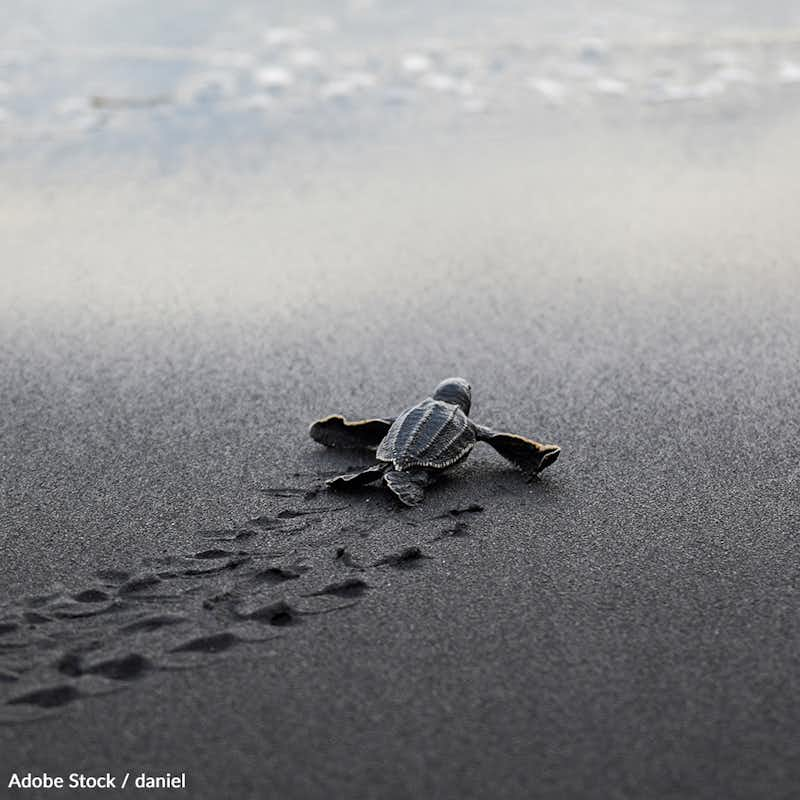Save the Leatherback: Pledge to Protect these Endangered Turtles
6,389 signatures toward our 30,000 Goal
Sponsor: The Rainforest Site
The beautiful and endangered leatherback turtle is facing a range of threats, from habitat destruction to plastic pollution. Help us tale action!

The leatherback turtle is the largest and most ancient species of turtle in the world, but it is also one of the most endangered. These massive reptiles, which can grow up to seven feet long and weigh over 2,000 pounds, are facing a number of threats that are pushing them toward extinction1.
One of the biggest threats to leatherback turtles is habitat loss. These turtles rely on specific beaches for nesting and reproduction, and the destruction of these habitats can have a serious impact on their survival. Coastal development, beachfront lighting, and other human activities can all disrupt the nesting process and make it difficult for leatherback turtles to find suitable breeding grounds2.
Another major threat to leatherback turtles is pollution. These turtles often feed on jellyfish, which can be found in large concentrations near areas of human activity. As a result, leatherback turtles are often exposed to pollution and other contaminants that can have negative impacts on their health3. Oil spills, plastic pollution, and other forms of marine debris can also pose a threat to leatherback turtles, as they can get tangled up in debris or ingest harmful substances4.
Climate change is also a major threat to leatherback turtles. Rising sea levels, coastal erosion, and extreme weather events can all have negative impacts on these turtles and their habitats. As the climate continues to change, it is likely that these impacts will become more severe, making it even more difficult for leatherback turtles to survive5.
Finally, leatherback turtles are also at risk due to overfishing and the illegal trade in turtle products. Many species of fish and invertebrates that leatherback turtles rely on for food are being overfished, making it difficult for these turtles to find sufficient nourishment6. Additionally, there is a thriving illegal trade in turtle products, such as shells and eggs, which can also have a serious impact on leatherback turtle populations7.
These reptiles are facing a number of threats that are pushing them toward extinction, including habitat loss, pollution, climate change, and overfishing, but there are steps that anyone can take to help save these incredible creatures from extinction.
Take the Pledge to Save Leatherback Turtles and make a difference in the fight to save these amazing animals from extinction!
- World Wildlife Fund (2023), "Leatherback Turtle."
- American Museum of Natural History, "Endangered: Leatherback Sea Turtle."
- Sea Turtle Conservancy (2022), "Information About Sea Turtles: Threats from Marine Pollution."
- Dalhousie University (16 March 2009), "Leatherback Turtle Threatened By Plastic Garbage In Ocean."
- The Leatherback Trust (2023), "Climate change."
- Sea Turtle Conservancy (2022), "Information About Sea Turtles: Threats from Illegal Shell Trade."
- The Conversation (22 October 2017), "The illegal turtle trade: Why I keep secrets."
The Pledge:
Leatherback turtles are facing a number of threats that are pushing them toward extinction, including habitat loss, pollution, climate change, and overfishing.
As such, I pledge to:
- Reduce my carbon footprint: Climate change is a major threat to leatherback turtles, as rising sea levels, coastal erosion, and extreme weather events can all have negative impacts on these turtles and their habitats. By reducing my carbon footprint, I can help to combat climate change and protect these animals.
- Reduce my plastic use: Plastic pollution is a serious threat to leatherback turtles, as they can get tangled up in debris or ingest harmful substances. By reducing my plastic use, I can help to protect these turtles and other marine life.
- Support sustainable seafood practices: Many species of fish and invertebrates that leatherback turtles rely on for food are being overfished, making it difficult for these turtles to find sufficient nourishment. By supporting sustainable seafood practices, I can help to ensure that these turtles have a steady food supply.
- Refuse turtle products: There is a thriving illegal trade in turtle products, such as shells and eggs, which can have a serious impact on leatherback turtle populations. By refusing to support this trade, I can help to protect these animals.
- Support organizations that are working to protect leatherback turtles, like Greater Good Charities and Project Peril. Project Peril is working to support community-based programs that effectively address threats to coastal habitats. These include removing beachfront lighting, physical barriers to nesting beaches, and vehicle traffic that crushes nests and incubating embryos. These programs also work toward reforestation, dune stabilization and beach clean-ups. Another key goal is the reduction of poaching and predation. Supporting these organizations through donations or volunteering can help to ensure that these turtles have a fighting chance at survival.
Through these actions, I pledge to make a difference in the fight to save these amazing animals.
Pledged by,